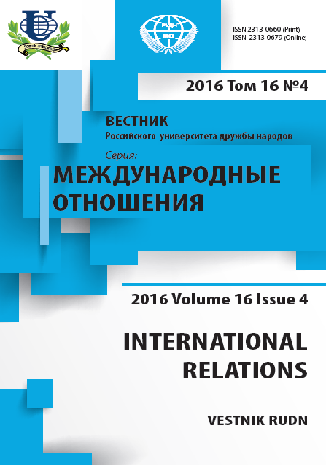Индия и БРИКС: «глобальный концерт» и региональный баланс
- Авторы: Стивэн ДМ.1
-
Учреждения:
- Берлинский научный центр социальных исследований
- Выпуск: Том 16, № 4 (2016): Иран и Индия в системе международных отношений
- Страницы: 595-602
- Раздел: Статьи
- URL: https://journals.rudn.ru/international-relations/article/view/15434
- DOI: https://doi.org/10.22363/2313-0660-2016-16-4-595-602
Цитировать
Полный текст
Аннотация
Индийские политики приветствовали восприятие Индии как «восходящей державы» и встретили единым фронтом инициативу БРИКС по реформированию аспектов глобального управления. Тем не менее, подъем Китая в Азии не установил баланс сил в регионе, и, как следствие, Индия нерешительно следует по пути стратегического сближения с США. Оценивая многостороннюю и геостратегическую дипломатию Нью-Дели, автор статьи делает вывод о том, что Индия на глобальном уровне присоединяется к БРИКС, однако на региональном уровне стремится сбалансировать Китай. На глобальном многостороннем уровне у Индии есть ряд общих точек соприкосновения с другими восходящими державами в области реформирования политики и структуры большинства международных организаций. Исключением являются Совет Безопасности ООН и Договор о нераспространении ядерного оружия, где КНР и Россия рассматриваются как ведущие державы. Тем не менее, на региональном уровне Индия поддерживает связи с Россией и культивирует прочные отношения с Соединенными Штатами Америки в попытке сбалансировать и увеличить рычаги влияния на возвышающийся Китай. Это подчеркивает, что проблемные области и институциональный контекст являются сильным связующим звеном для основных конкурирующих сил.
Об авторах
Д Мэтью Стивэн
Берлинский научный центр социальных исследований
Автор, ответственный за переписку.
Email: matthew.stephen@wzb.eu
Берлин, Германия
Список литературы
- Armijo, Leslie Elliott, Roberts, С. (2014). The Emerging Powers and Global Governance: Why the BRICS Matter. In Handbook of Emerging Economies. Ed. by Robert Looney. New York: Routledge, pp. 503-524
- Blank, St. (2007). The Geostrategic Implications of the Indo-American Strategic Partnership. India Review, 6 (1), pp. 1-24
- Chin, G. (2010). Remaking the Architecture: The Emerging Powers, Self-Insuring and Regional Insulation. International Affairs, 86 (3), pp. 693-715
- Efstathopoulos, Ch. (2012). Leadership in the WTO: Brazil, India and the Doha Development Agenda. Cambridge Review of International Affairs, 25 (2), pp. 269-293
- Helleiner, E., Kirshner, J. (2009). The Future of the Dollar: Whither the Key Currency? The Future of the Dollar. Edit. by Eric Helleiner and Jonathan Kirshner. Ithaca, NY: Cornell University Press, pp. 1-23
- Hopewell, K. (2014). Different Paths to Power: The Rise of Brazil, India and China at the World Trade Organization. Review of International Political Economy, 22 (2), pp. 311-338
- Khilnani, S., Kumar, R., Mehta, P.Bh., Menon, P., Nilekani, N., Raghavan, S., Saran, Sh., Varadarajan, S. (2012). NonAlignment 2.0: A Foreign and Strategic Policy for India in the Twenty First Century. New Delhi: Centre for Policy Research
- Mehta, P.B. (2009). Still Under Nehru’s Shadow? The Absence of Foreign Policy Frameworks in India. India Review, 8 (3), pp. 209-233
- Nafey, A. (2005). IBSA Forum: The Rise of ‘New’ Non-Alignment. India Quarterly: A Journal of International Affairs, 61 (1), pp. 1-78
- Narlikar, A. (2013). India Rising: Responsible to Whom? International Affairs, 89 (3), pp. 595-614
- Nayar, B.R., Paul, T.V. (2003). India in the World Order: Searching for Major Power Status. Cambridge: Cambridge University Press
- Nel, Ph. (2010). Redistribution and Recognition: What Emerging Regional Powers Want. Review of International Studies, 36 (4), pp. 951-974
- Pant, H.V., Super J.M. (2015). India’s ‘Non-Alignment’ Conundrum: A Twentieth-Century Policy in a Changing World. International Affairs, 91 (4), pp. 747-764
- Rapkin, D., Thompson, W. (2003). Power Transition, Challenge and the (Re)Emergence of China. International Interactions, 29 (4), pp. 315-342
- Rehman, I. (2009). Keeping the Dragon at Bay: India’s Counter-Containment of China in Asia. Asian Security, 5 (2), pp. 114-143
- Sarkar, R. (2016). Trends in Global Finance: The New Development (BRICS) Bank. Loyola University Chicago International Law Review, 13 (2), pp. 89-103
- Schweller, R.L. (1994). Bandwagoning for Profit: Bringing the Revisionist State Back In. International Security, 19 (1), pp. 72-107
- Stephen, M.D. (2012). Rising Regional Powers and International Institutions: The Foreign Policy Orientations of India, Brazil and South Africa. Global Society, 26 (3), pp. 289-309
- Stephen, M.D. (2014). Rising Powers, Global Capitalism and Liberal Global Governance: A Historical Materialist Account of the BRICs Challenge. European Journal of International Relations, 20 (4), pp. 912-938
- Stephen, M.D. (2017) forthcoming. Emerging Powers and Emerging Trends in Global Governance. Global Governance
- Stephen, M.D., Parizek, M. (2015). New Pressures on the WTO: The Rise of Illiberal Trading States. Paper Presented at the 8th Annual Conference on the Political Economy of International Organizations. Berlin: Hertie School of Governance
- Tellis, A.J. (2005). India as a New Global Power: An Action Agenda for the United States. Washington D.C.: Carnegie Endowment for International Peace
- Vestergaard, J., Wade, R.H. (2015). Still in the Woods: Gridlock in the IMF and the World Bank Puts Multilateralism at Risk. Global Policy, 6 (1), pp. 1-12
- Vezirgiannidou, S.-E. (2013). The United States and Rising Powers in a Post-Hegemonic Global Order. International Affairs, 89 (3), pp. 635-651
- von Freiesleben, J. (2013). Reform of the Security Council. In Governing and Managing Change at the United Nations. Ed. by Lydia Swart and Estelle Perry. New York: Center for UN Reform Education, pp. 1-22
- Wohlforth, W. (1999). The Stability of a Unipolar World. International Security, 24 (1), pp. 5-41
- Wolf, R. (2011). Respect and Disrespect in International Politics: The Significance of Status Recognition. International Theory, 3 (1), pp. 105-142
- World Bank (2016). Global Economic Prospects: Divergences and Risks. Washington D.C.: World Bank Group
- Ying, F. (2016). How China Sees Russia: Beijing and Moscow Are Close, but Not Allies. Foreign Affairs, 95 (1), pp. 96-105











